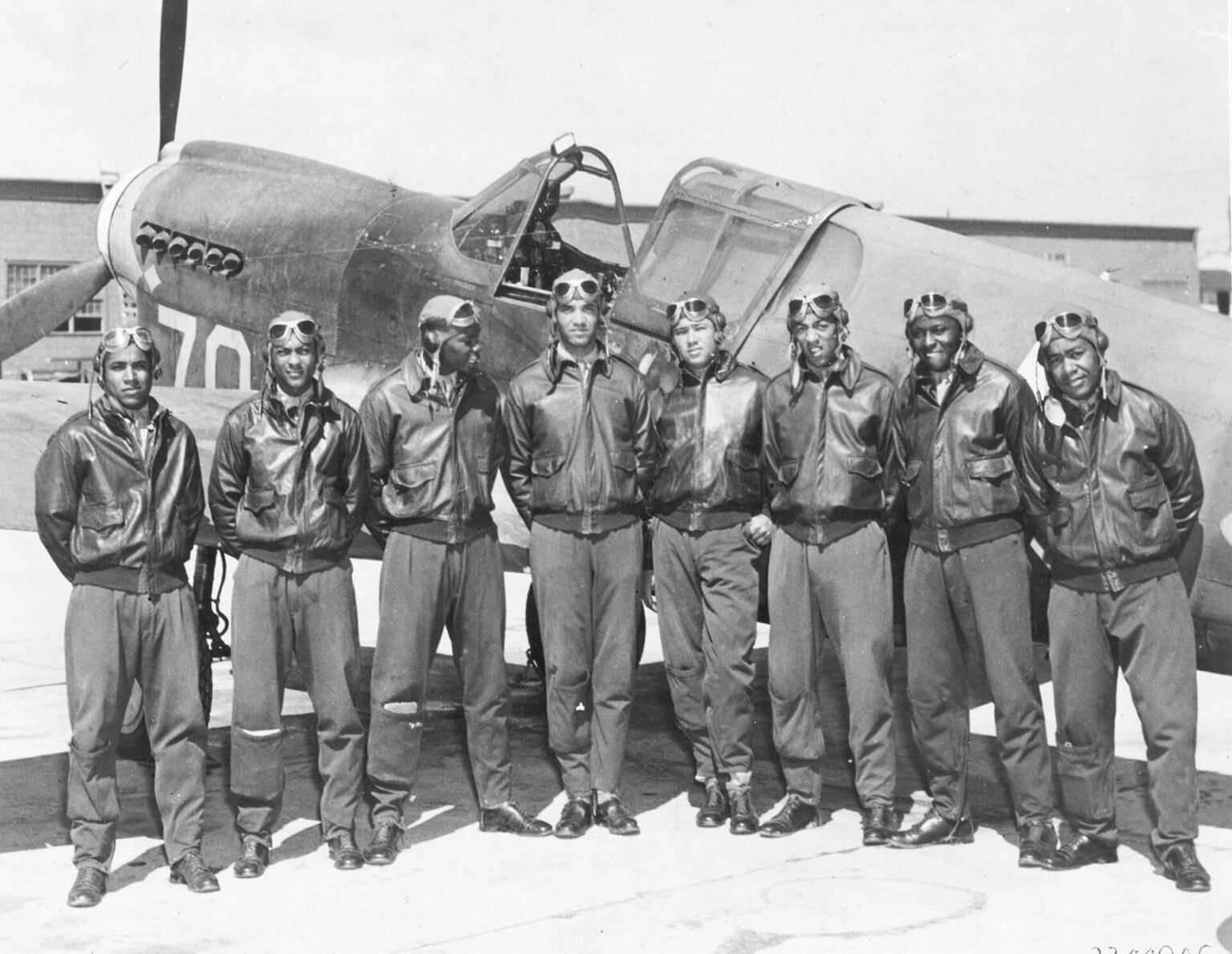Do you know about the great Black pilots Tuskegee Airmen? You may know, but I want to remember them once again. They made history. They showed the way to break systemic racism and build equality. Why can’t we erase them from our memory? Because they not only conquered their present, they also paved the way for the future. They fought for freedom against discrimination.
The Tuskegee Airmen were the first African American military pilots in the United States Armed Forces. What’s the Tuskegee Airmen’s definition? African American soldiers tried to be pilots for a long time. But their efforts were rejected over and over. High officials had a belief that the Black soldiers were not competent to be pilots. But the sky warriors proved that myth wrong. Was it so easy? How much suffering did those fearless aviators endure to prove themselves? Let’s see.
Who Were the Black Pilots Tuskegee Airmen?
What is Tuskegee Airmen? The Tuskegee Airmen were Black, brave, unstoppable fighters. They fought in World War II. They were the first African American Black pilots in the United States Army Air Forces (USAAF). First, they had to take part in an experimental pilot training program. Later included with the 332nd Fighter Group and 477th Bombardment Group. The Tuskegee Airmen name also applies to the instructors, navigators, mechanics, crew chiefs, nurses, cooks, and support personnel.
Their journey was not easy at all. They faced the complex challenges to prove their competencies. They showed remarkable courage in World War II. They were trained by U. S. Army Air Corps, which changed the name to U. S. Air Force later. The Tuskegee Airmen received three distinguished awards from the United States for their incredible war effort.
The training program was launched in 1941 at Tuskegee Army Air Field in Tuskegee, Alabama. That’s why they were named as “Tuskegee Airmen“. Not only the pilots but also other support staff were Tuskegee Airmen who made the missions possible.

Why Was the Program Created?
You will be surprise to know the efforts African American soldiers put into establishing equality. They were the pioneers, and the pioneers always are to go through challenges. Black soldiers were not allowed to serve as pilots at the time. And they were considered unqualified for the job. But they wanted to work and they wanted to prove themselves. They had many challenges ahead of them. They broke the bar of systemic racism; they broke the prejudice of incompetence. They made the path to rethink Black excellence.
President Franklin D. Roosevelt amended an appropriations bill in April 1939 for funding the training program for Black pilots. The government established the all-Black 99th Pursuit Squadron with these trained Black American forces in 1941. Surrounding circumstances and the outbreak of World War II pushed this to happen. Later, they were included with the 332nd Fighter Group at Tuskegee, Alabama. NAACP, the civil rights organization, and a prominent leader, A. Philip Randolph made a significant contribution to this inclusion.
Thus, the Tuskegee Experiment was born, not only to train the Black pilots but also to test their capabilities. The Tuskegee Airmen proved themselves and became the most efficient and most successful escort group.
How Was the Training at Tuskegee?
Can you realize the bravery of those people who wanted to fight for the country? The stake was their life. Those fearless heroes who just wanted equal rights. How they were treated during their training days? The training to be a pilot was gruelling. The pilots had attended ground school at Tuskegee Institute first. Tuskegee Institute, founded by Booker T. Washington, converted to today’s famous Tuskegee University. The historical Black College, Tuskegee University, made a greater contribution to the success of the Tuskegee Airmen.
After that, they had to move to the Tuskegee Army Air Field for flight training. They were segregated part of the military pilots. The training was rigorous, and comparatively, the standard was higher than white pilots. They had to face discrimination for resources and facilities. Some of their mentors also showed racist attitudes towards Black pilots. They showed their doubts about Black pilots’ capabilities and intelligence. That’s why they delayed the Airmen’s deployment.
However, the cadets proved their views wrong. They showed their excellence in the field. About 1000 Black pilots were trained at Tuskegee between 1941 and 1946. Amongst them, about 450 pilots were deployed to fight in Europe and North Africa.

How the Tuskegee Airmen Proved Their Excellence?
The Black pilots Tuskegee Airmen distinguished themselves with their courage and efficiency in combat. They earned respect not just from their units but also from allied forces. Even those who previously criticized Black pilots had praised them. They flew more than 15000 sorties and accomplished over 1500 missions during World War II.
The Tuskegee Airmen left their mark on their skills as fighter escorts for U.S. bombers over Europe. As it happens, they earned a nickname—Tuskegee Airmen Red Tails. They flew P-51 Mustangs, which had distinctive red tails. Thus, the Airmen earned that name as Red Tails. They were so skilled at saving bomber crews that they earned a special kind of respect for it. P-40 Warhawk, P-39 Airacobra, and P-47 Thunderbolt were other Tuskegee Airmen airplanes.
The Black Pilots Tuskegee Airmen Awards
Several Tuskegee Airmen became flying aces like Lee Archer. They shot down at least five enemy aircraft in combat. Lee Archer was one of the first Black flying aces in U.S. history.
They earned a record of shooting down three German jets in a single day. That was not so easy to overcome, thrust against the advanced German technology.
The Tuskegee Airmen earned numerous honourable medals and awards for their impeccable war efforts. The most significant Tuskegee Airmen awards are Distinguished Flying Crosses, Legion of Merit, Purple Hearts, Silver Stars, etc.
Did They Face Discrimination after War?
You might feel shock to know that the Black heroes had to face racism and discrimination during and after the war. But they fought against the segregation within the military. One infamous incident happened in 1945, which was called the Freeman Field Mutiny. It happened when the Black officers protested against segregated officers’ clubs. About a hundred Black officers were arrested.
But the success and reputation of the Tuskegee Airmen helped to change the situation. President Harry S. Truman signed Executive Order 9981 in 1948. That declared the end of segregation in the armed forces. Their brave contribution to the war later helped establish their rights.
The Legacy of the Tuskegee Airmen
The bravery of Black pilots still inspires the youth of the new era. People still carry the Tuskegee legacy in various ways. They have been honored with the most prestigious awards in the United States. Many monuments and museums have been built to honor them. Famous filmmakers created documentaries, movies based on their brave actions to preserve their stories.
Tuskegee Airmen, Inc., a non-profit organization, works to encourage young people to pursue aviation careers. The outstanding courage and ability of Black pilots later accelerated the civil rights movement.
How Many Tuskegee Airmen Are Still Alive?
Sergeant First Class Thomas Franklin Vaughns celebrated his 105th birthday on July 7, 2025, in Pine Bluff, Arkansas. He is an American veteran and an African American Tuskegee Airman. He received the Congressional Gold Medal award in 2006 for his outstanding contribution to World War II. He was awarded the National Defense Service Medal in 2019 for his service in the Korean War.
According to Tuskegee Airmen, Inc., about sixteen veterans and Tuskegee Airmen from the original World War II era are still alive. Amongst them, Lt. Col. George Hardy is the only surviving pilot of World War II. He flew combat missions with the great 332nd Fighter Group in World War II. Another pilot and Tuskegee Airmen Lt. Col. Harry T. Stewart Jr. had passed away on February 2, 2025. The remaining Tuskegee Experience veterans were from support crews, ground personnel, etc.
The survivors are Col. James H. Harvey III, Lt. Eugene J. Richardson Jr., James Clayton Flowers, and Lt. Col. Enoch “Woody” Woodhouse.
How Can You Honor Their Memory?
If the Black Pilots Tuskegee Airmen, inspire you, how will you learn more about them?
- You can visit the “Tuskegee Airmen National Historic Site” in Tuskegee, Alabama. It is one of the most significant Alabama historical sites. Its name was “Moton Field” during World War II—the Tuskegee Airmen’s primary training facility.
- The “Tuskegee Airmen National Museum, Detroit” is another historic tribute to the great heroes.
- You can watch documentaries or films about their lives, such as the 1995 HBO Film “The Tuskegee Airmen” or the movie Red Tails (2012).
- Support scholarships and aviation programs to encourage young people.
- Share their story with others to keep their memory alive.
- If you want to know more about Black history and culture, you can read the book Black Landscapes Matter by Walter Hood.
- If you are an architect, you can pay tribute through your design. KIJIJI ATLANTA, a group of designers who rebuild the Black neighbourhood to carry the legacy to future generations.
Why Should the Tuskegee Legacy Carry Forward?
Discrimination has not ended yet, and equality has not yet been fully established. That laid the ground for the Black Lives Matter movement to happen, which is continuing. That’s why we have to follow the path they showed us to rebuild the Black neighbourhood. We must work courageously to establish equality. The Tuskegee legacy is our inspiration in doing that work.
We can remember Grammy award-winning musician, poet, and actor Malcolm-Jamal Warner, who spoke about “Black Excellence.” In the last episode of his podcast “Not All Hood”, he shared about it, which was published on July 18, 2025. He said a report by The Washington Post made him rethink the history. The report was about Arlington National Cemetery, where they are erasing the history of great Black soldiers from their website and documents. The Cosby Show actor said Black soldiers are the most patriotic fighters in the world. They struggled for that freedom which they never enjoyed.
The actor Malcolm-Jamal Warner died on July 20, 2025, in Costa Rica. He played the role of “Lieutenant Leroy Cappy” in the 1995 HBO TV film “The Tuskegee Airmen”. He carried the brave Black Pilots’ Tuskegee Airmen Legacy through his words. He reminded us to preserve the history for future generations. Because Black Landscapes Matter.
Learn more about Black history, read our previous post: Black Landscapes Matter.







